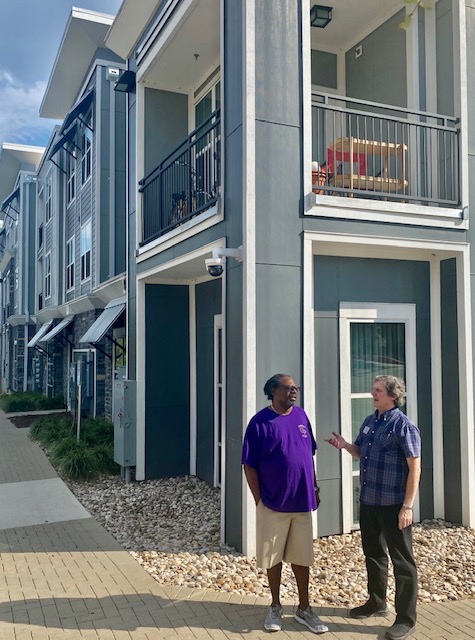HOUSING AFFORDABILITY

I'm proud of the work we did with Ken and HACA to turn 40 really old units into 120 brand new apartments at Goodrich Place. Zilker is a great neighborhood - we have a bus nearby, a great school for the kids, and a park. I was worried the place would just get torn down - but instead my neighbors and I can still live here and were part of designing a place we can enjoy and call home.
There is no debate that Austinites need more affordable places to live in Austin. But the debate on how we do it has created battles across the city. I reject the business as usual “I win, you lose” politics that has characterized Austin for years. We should be able to build more affordable housing across the city while carefully preserving and improving existing neighborhoods and their streets, water quality, flooding control, and parks. I remain hopeful that most Austinites agree we must continue to support those most in need, work to reduce building costs, and strengthen planning to prepare and address our diminishing affordability and high growth. I list my ideas below.
Concern about housing affordability is a common concern across District 5. I have learned that effective solutions must also address existing housing and the market factors unique to each area. I also believe District 5 residents want places that make their lives easier with access to groceries, retail, restaurants, parks, green space, and other services including educational and cultural opportunities.
I have recent experience working as a Senior Policy Advisor for District 5 on several successful housing projects, including the following two examples:
Zilker Neighborhood. One with the Zilker Neighborhood and the Austin Housing Authority to preserve and expand existing affordable housing at Goodrich Place. Zilker is a neighborhood with older, affordable multi-family housing properties in need of preservation because the market is quickly rebuilding much of the area with larger single family homes. At Goodrich, collaborative work resulted in 40 older units being replaced with 120 brand new apartments, all of which are affordable with rents based on the person’s income.
Parkside Neighborhood. Another was in the Parkside neighborhood east of IH-35 . We worked to increase housing while also providing needed sidewalk improvements on a substandard road (Brandt Road) and dedicating approximately 18 acres as additional green space to a bordering preserve. This project added approximately 200 units of affordable housing, available to families making at or below 60% of the median family income (about $61,000 for a family of four).
Steps I will take to reduce housing costs and help Austinites buy or rent homes:
Support Those Most in Need
- Support preservation of older, more affordable condominiums and apartments to discourage demolition and keep rental costs down
- Provide home repair, rental assistance and tenant protections to keep people in their homes
- Prioritize use of subsidies to lower rents for lowest income renters and homeowners
- Offer down payment assistance to help with purchase
Reduce Building Costs
-
- Reduce building cost by expediting permitting, reducing fees for affordable housing, and ensuring city departments coordinate reviews better to save time and money
- Encourage smaller, more affordable housing types including ADUs, tiny homes, prefab housing, and 3-D printed homes
- Build more housing and retail on bus/rail corridors and reduce creating excess parking spaces
Strengthen Planning
-
- Track and hold the city accountable for meeting affordable housing targets
- Limit the number of full time STRs which removes housing from the market
- Work harder for more affordable housing in large projects like PUDs
- Focus Land Development Code changes on those that preserve affordable housing, expand housing types, and reduce housing costs
- Use vacant city, county, state and school properties to build more affordable housing
- Use district level and eTOD planning to help identify land use, zoning, financing, and other tools to develop affordable housing.
